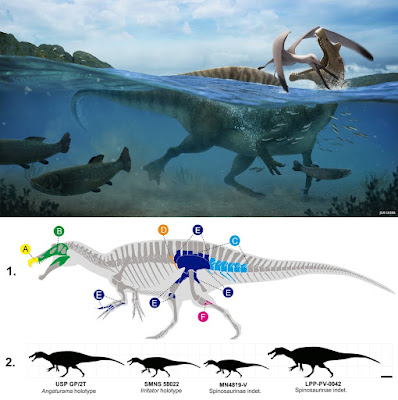 |
| A Spinosaurinae at the Aptian-Albian lagunar/shallow marine environment of the Romualdo Formation, Araripe Basin, NE Brazil.
in Aureliano, Ghilardi, Buck, et al., 2018.
Illustration by Julio Lacerda.
|
Highlights
• Spinosaur histology is here described for the first time.
• Extreme bone compactness (osteosclerosis) was present in Brazilian Spinosaurinae.
• These modifications appeared millions of years before the Moroccan Spinosaurus.
• One of the largest spinosaur specimens from the Early Cretaceous of South America.
Abstract
Spinosaurinae are known to have a strong relationship with aquatic environments, involving several anatomical adaptations. Nonetheless, this group of theropods remains enigmatic, due to the relative incompleteness of its fossil record. A large partial tibia from the Aptian-Albian Romualdo Formation, Northeast Brazil, is herein described through anatomical comparisons and paleohistological analyzes. It features characteristics previously only observed in Spinosaurus aegyptiacus, which includes a reduced fibular crest and an osteosclerotic condition. The later, a character supported as correlated with semi-aquatic habits in many limbed vertebrates. The results presented here support high bone compactness being already present in Brazilian Spinosaurinae millions of years before the Moroccan Spinosaurus. Furthermore, histological analyses demonstrate the Romualdo Formation specimen was a young subadult still growing fast by the time of its death, and suggests Araripe Basin Spinosaurinae could have grown larger than previously thought. This work contributes to a better paleobiological and ecological understanding of South American spinosaurs, and helps fill a gap in the macroevolutionary comprehension of Spinosaurinae. Ultimately, it also contributes to further advancing the paleoecological characterization of the Romualdo Formation.
Keywords: Paleohistology; Araripe basin; Theropoda; Megalosauroidea; Spinosaurinae
Systematic paleontology
Dinosauria Owen, 1842
Theropoda Marsh, 1882
Tetanurae Gauthier, 1986
Megalosauroidea Fitzinger, 1843
Spinosauridae Stromer 1915
Spinosaurinae Stromer, 1915
gen. et. sp. indet.
gen. et. sp. indet.
Referred material: LPP-PV-0042, a fragmentary tibia.
Locality and horizon: Exact geological and geographical provenance is unknown, but the fossil was collected in the Araripe area, Northeast Brazil. Outcrops of the Lower Cretaceous Santana Group (Araripe Basin) are worldwide known for providing well-preserved fossils and are located in the Araripe region.
 |
Fig. 8. Reconstruction of a Spinosaurinae at the Aptian-Albian lagunar/shallow marine environment of the Romualdo Formation, Araripe Basin, NE Brazil.
Illustration by Julio Lacerda.
|
Conclusion:
The Romualdo Formation specimen LPP-PV-0042 comprises a fragmentary tibia with a reduced fibular crest and osteosclerotic histology previously only observed in Spinosaurus aegyptiacus, supporting that this unique feature was already present in Brazilian Spinosaurinae (basal Spinosaurinae) during the Aptian-Albian time, at least 10 myr before the Moroccan Spinosaurus.
Histological analyses suggest LPP-PV-0042 was a young, fast growing subadult and also that the bone microstructure varies a lot across the cross-section, probably due to areas of muscle insertion. The latter observation suggests that caution is needed when describing bone histology of dinosaurs, since only one slice from the shaft is not always representative of the entire histology of the bone.
Furthermore, the current specimen represents one of the largest spinosaurs from this unit so far (∼10 m in reconstructed TL). It was larger than the Irritator holotype and possibly larger than Angaturama holotype as well. Considering the subadult status inferred from its histology, the referred individual would have grown even larger.
The Romualdo paleoenvironment could support large predators with semi-aquatic habits due to its high productivity and diversity of aquatic species as an ecotone. Spinosaurinae from Romualdo Formation probable occupied the position of apex predators different.
Thus, the skeletal element LPP-PV-0042 from the Romualdo Formation, although fragmentary, has provided much information about Brazilian Spinosaurinae paleobiology and ecology. Moreover, it gives new insight into the evolution of semi-aquatic adaptations in this group, revealing the need to investigate other taxa within the clade and expand the search for more spinosaur fossils.
Tito Aureliano, Aline M. Ghilardi, Pedro V. Buck, Matteo Fabbri, Adun Samathi, Rafael Delcourt, Marcelo A. Fernandes and Martin Sander. 2018. Semi-aquatic Adaptations in A Spinosaur from the Lower Cretaceous of Brazil. Cretaceous Research. In Press. DOI: 10.1016/j.cretres.2018.04.024
twitter.com/AlineGhilardi/status/992152367633240065
Dense Bones and Other Aquatic Adaptations in Spinosaurs https://blog.everythingdinosaur.co.uk/blog/_archives/2018/05/06/dense-bones-and-other-aquatic-adaptations-in-spinosaurs.html




